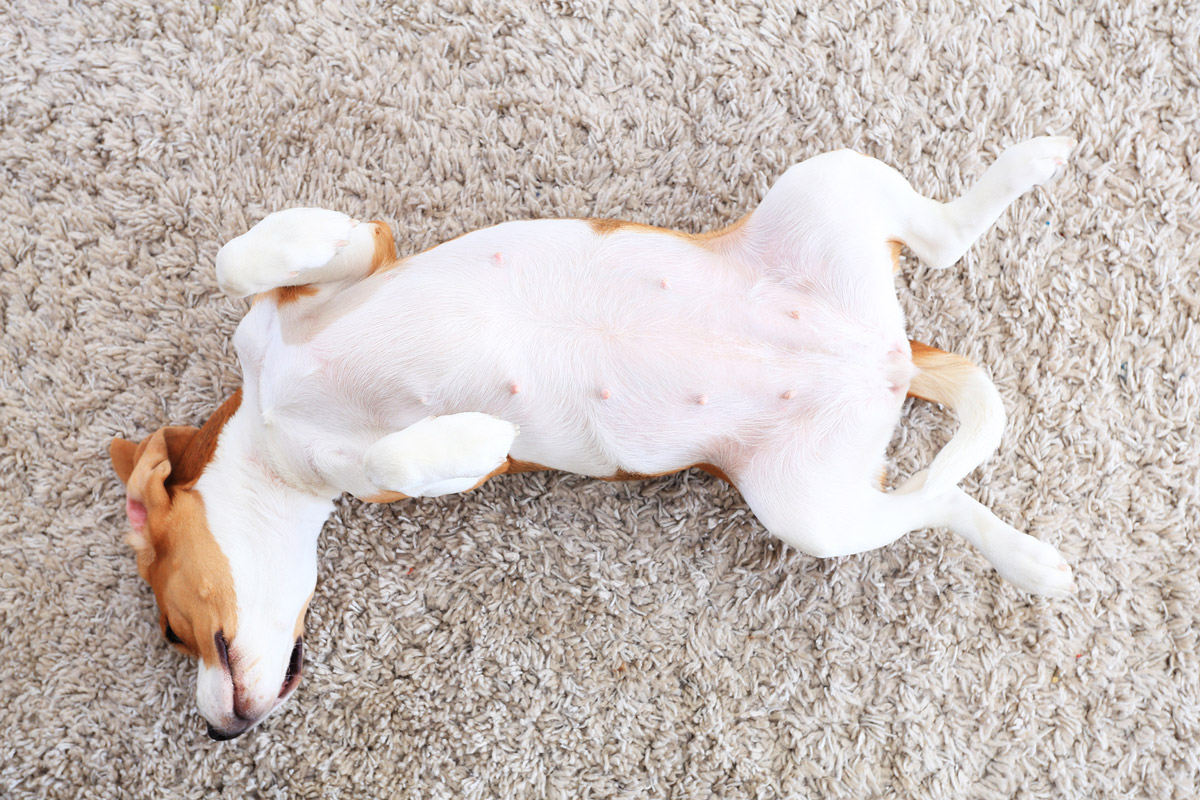Are You Causing Your Pet Skin Problems?

Note: This article was written for and originally posted on Silversky .
Is your dog scratching itself more than usual? Did you flip him over only to realise that his once clear belly skin is now splotchy and red? Your pet might be suffering from a skin problem!
But before you panic, it’s good to note that most skin problems can often be treated fairly easily. That said, because it causes discomfort to your pet, it’s still important to know what are some common skin problems and their possible causes so that you can protect your pet from them.
Firstly, what should my pet’s skin look like?

Generally, your pet’s skin should either be pink or black, depending on its breed and genetic history. Every pet’s skin will also be uniquely pigmented and should feel smooth to the touch, as well as be free of crusting, scaling, black or white spots, itching, and infected, hot, or inflamed areas.
Your pet’s coat should also be glossy and full (the thickness depends on its breed) and without bald patches, dandruff, and fleas or mites. Your pet may also shed all year round, but usually, it moults the most during the months of summer and autumn (June to November).
What are the signs of a skin problem?

If you notice any of these signs in your dog or cat, it might be suffering from a skin problem:
- Excessive scratching
- Lesions and scabs
- Hair loss and bald patches
- Dry, flaky skin
- Redness and hot spots
- Rashes
- Swelling and lumps.
Do note that skin covers not just the outside but also the inside of your pet’s ears, so make sure to check them carefully for flaky skin, redness, or brownish discharge too!
Common skin problems & their causes

1. Hair Loss (Alopecia)
Alopecia can happen for a multitude of reasons, which include skin allergies, hormonal imbalance, and poor nutrition – simply filling your pet’s tummy is not enough; every meal needs to provide your pet with its daily required nutrients and minerals!
Hair loss can also be a secondary result of a fungal infection or skin parasites, which causes the pet to scratch or lick itself excessively due to skin irritation and an unbearable itch.
2. Skin Allergies
If your pet’s skin is inflamed with lesions, hair loss, or darkened skin tone and you see your beloved furry friend scratching itself often (usually around the belly, ears, or along its sides) as well as rubbing its face and chewing its paws, it might be having an allergic reaction!
Allergies can develop at any stage in your pet’s life, and many substances can act as allergens that cause a skin allergy to occur. These include:
- Inhaled allergens such as moulds, pollen, and house dust
- Flea saliva
- Contact allergens such as soaps, household chemicals, and feathers
- Food allergens such as beef, dairy, wheat, egg, chicken, and lamb.
Because there are so many potential allergens, finding out what exactly your pet is allergic to will require educated detective work. To make the process easier for yourself, bring your pet to the vet for skin testing to rule out environmental allergens. From there, it’s likely to be a food allergy, which will require an elimination diet.
3. Ringworm
For those of you who notice dandruff-like flaking of the skin, red lesions on the head, chest, forelegs, and ridge of the back, as well as circular patches of hair loss on your pet, it might be a case of ringworm, which is a fungal infection.
Ringworm only spreads through direct contact with the fungus itself, which means that your pet must have come into contact with an infected animal or person, or touched a contaminated object. As ringworm is contagious, it’s best to rush your pet to a vet the instant you detect signs of it!
To prevent further spread of the infection to yourself, your family, and your other pets, you’ll have to disinfect your entire house and get rid of all the loose hairs. This is because the fungal spores are found in infected hair follicles, and when these infected hairs drop, the spores remain contagious for months.
Make sure to thoroughly and regularly clean areas that often have hair on it, such as your couch, grooming tools, bedding, furniture, and clothing. If you have a confirmed case of ringworm in your household, daily vacuuming and removal of hair from furniture and surfaces would be needed.
4. Yeast Infection
Yeast infections are itchy, crusty, and smelly. If your pet’s rash develops into thickened skin with an elephant skin-like appearance, your pet might be having a yeast infection.
While not contagious, the odour can be particularly off-putting, and the itch will be immense for your four-legged friend. Particularly common in hot, humid environments, yeast infection is caused by an overgrowth of the Malassezia species of yeast, which are normal inhabitants of the skin, ears, and mucocutaneous areas and usually kept under control by the immune system. A common cause of this overgrowth is a suppressed immune system or a change in skin condition such as an increase in the amount of oils produced on the skin.
5. Hot Spots
Typically well-defined areas of redness, swelling, and hair loss, hot spots can vary in size and are caused by excessive licking, biting, or scratching of a particular area of your pet’s body. While they can occur on any part of the body, they often appear on the head, limbs, and hips, and the affected area may discharge pus or fluid, which in turn leads to crusting and matting of the surrounding fur.
The reasons why your pet might fervently lick, bite, or scratch an area can vary from behavioural issues like obsessive-compulsive disorder, separation anxiety, or boredom to external factors such as parasites, allergies, contact irritants, or a dirty coat. This means that to prevent hot spots from developing, you’ll need to practice good hygiene, routine grooming, and provide your pet with plenty of physical activity and mental stimulation to alleviate its stress or boredom.
6. Pyoderma
If you notice symptoms such as red bumps, flaking skin, skin discolouration, excessive shedding, redness, and pustules, which are red and raised with a white pus-filled centre, your pet might be suffering from pyoderma.
A skin infection that causes lesions, pustules, and alopecia, pyoderma is usually bacterial and superficial. While it can be due to hypothyroidism and Cushing disease, if your pet is otherwise healthy, pyoderma is often secondary to a variety of other fungal or parasitic conditions caused by allergies, fleas, and poor grooming.
7. Seborrhea
Often an inherited disorder that causes flaky skin and/or greasy skin and hair, seborrhea cannot be prevented in such cases, but it will have to be managed in order to prevent secondary skin problems such as hot spots and yeast infections from happening. To do so, regular grooming is needed to keep your pet’s skin and coat clean and healthy.
However, seborrhea can also develop because of underlying medical conditions like autoimmune and malabsorption disorders, dietary deficiencies, parasites, and allergies.
What should I do for prevention & treatment?

To significantly reduce the chances of your pet developing the above-mentioned skin problems, all you need to do is to:
– Avoid known allergens
– Keep your home clean at all times (vacuum all that hair regularly!)
– Groom your pet thoroughly and regularly
– Ensure sufficient physical and mental stimulation
– Provide a balanced diet — known for their complete and balanced recipes, try out the well known Wellness CORE series with some sample packs here!
If your pet does show signs of a skin condition, however, fret not. Simply confirm your suspicions with a trusted vet in Singapore and work out a treatment plan together. If your pet’s skin problems are not autoimmune-related, due to hormonal issues, or a secondary result of other underlying medical conditions, there are often steps that you can take as a pet owner to provide some relief to your beloved and improve its skin condition at home.
This includes switching out its usual shampoo with one that is specially-formulated to improve skin health in pets, such as OxyMed’s Hypo-Allergenic Oatmeal Shampoo. A simple cleansing solution, it’s highly effective yet gentle on your pooch’s skin. Made with coconut and enriched with Vitamin E, Aloe, and oatmeal, it provides soothing relief and moisturises and conditions the skin and coat as well.
At the end of the day, there’s no need to panic or beat yourself up if you realise that your pet is suffering from skin problems, as it won’t do your pet any good. What you can and need to do is to simply bring your pet to a clinic to receive medical attention as soon as possible, and listen to what the vet has to advise!









